December 20, 2021 feature
Reentrant tensegrity: An auxetic, three-periodic, chiral tensegrity structure
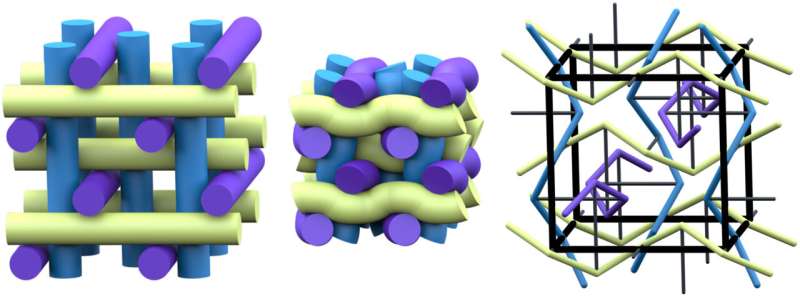
In a new report now published in Science Advances, Mathias Oster, and a team of scientists at the Institute for Mathematics at the Berlin Institute of Technology and the School of Engineering at the University of Edinburg in the U.K., presented a three-periodic, chiral tensegrity structure and demonstrated that it is auxetic, i.e., such materials become thicker perpendicular to the applied force when stretched. An auxetic structure has a negative Poisson's ratio and can form materials with unexpected behavior. The tensegrity structure is a form of tensile architecture held together by the balance of tensile and compression forces acting on them. The scientists constructed the tensegrity structure using chiral symmetry cylinder packing to transform cylinders to elastic elements and cylinder contacts to incompressible rods. The outcome showed local re-entrant geometry at its vertices, which they confirmed using finite element modeling. The architecture represented a simple three-dimensional (3D) analog to the two-dimensional (2D) re-entrant honeycomb model to form an interesting design target for multifunctional materials.
Tensegrity in the lab
In this work, Oster et al. proposed a previously unknown 3D auxetic structure with auxetic behavior, as an idealized geometric motif and simulated elastic material. To begin with, the team focused on tensegrity—a term that defines integrity under tension. The term originated from the architectural work of Kenneth Snelson and Buckminster Fuller to use tensegrity structures as a combination of tension and compression forces to provide the illusion of rods floating in space. Tensegrity can combine two type of design elements known as strut and cable elements under tension to stabilize the structure, where cables keep vertices close together, while struts hold them apart. The purity and simplicity of tensegrity can lead to a very natural mathematical description. Mathematically, tensegrity can be described as a set of vertices that fulfill simple distance constraints. Researchers have made an interesting parallel to the spatial constraints of tensegrity structure by using sphere packings, to explore their configurations and stability.
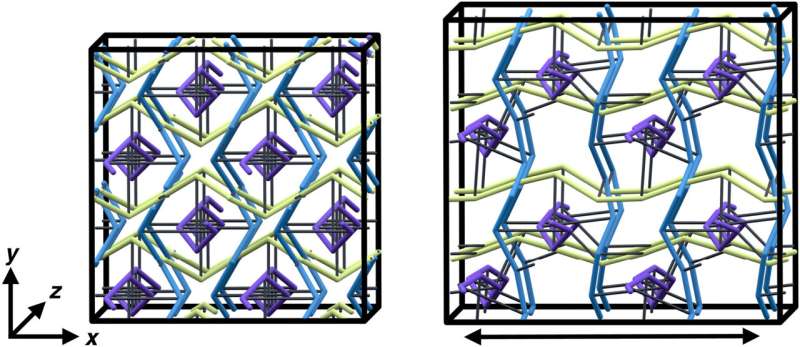
Much like sphere packing, crystalline materials can be similarly described via periodic packing of cylinders in 3D space. In this instance, the cylinders represented rods of strongly bonded atoms or groups of atoms. For instance, the 3D structure of the mineral garnet is well known, but the use of cylinder packings provided a simpler description to understand the structure. Inspired by the parallel between tensegrities and sphere packings, Oster et al. constructed a tensegrity structure using helical cylindrical packing by reimagining the structure as a series of rigid rods suspended in space by a periodic web of elastic filaments to form a periodic tensegrity structure. The reentrant geometry of the vertices suggested auxetic behavior, which Oster et al. studied in depth.
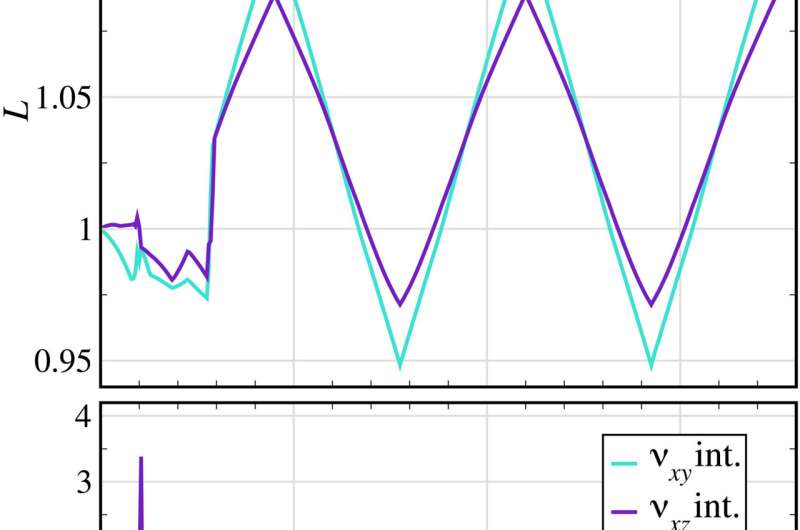
Simulating the tensegrity structure
The team then observed the equilibrium configurations and quasi-static deformations of the constructed periodic tensegrity structure. At the beginning of simulated deformations, they analyzed the configurations corresponding to the densest packing within a fixed unit cell. Using Newton's method, Oster et al. confirmed the structure to be an equilibrium configuration. The scientists used several methods to verify the results. The phase of deformation immediately after the initial loss of symmetry of the structure provided an interesting viewpoint from the disciplines of both material science and mathematics. Thereafter, the team focused on the engineering potential to realize these idealized geometric constructions by extending the concept of auxetic periodic tensegrity structures to finite 3D lattices composed of elastic elements. The driving force toward auxeticity depended on the interplay between geometry and elasticity. To then expand these concepts with materials, Oster et al. explored 3D printing of a toy model of the structure, which they accomplished by printing the constructs using a rubber-like thermoplastic polyurethane to observe mild auxetic behavior of the structure.
-
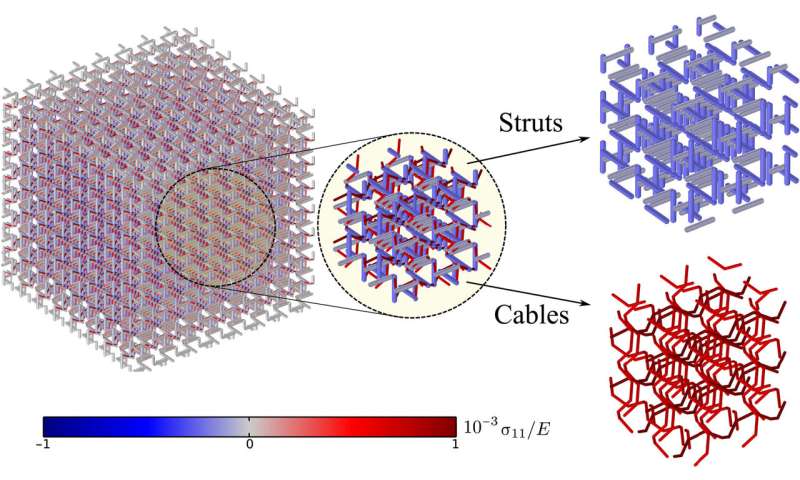
Tension and compression of the tensegrity elements. 8 × 8 × 8 lattice for dc/ds = 0.6. The color map represents the level of axial stresses σ11, normalized by the Young’s modulus E, along the elements’ arc lengths. The inset shows a representative volume and further the dissection of the cable and the strut elements to show that they are subjected to tension and compression, respectively. The deformed configurations are shown at 0.025 strain. Credit: Science Advances, 10.1126/sciadv.abj6737 -
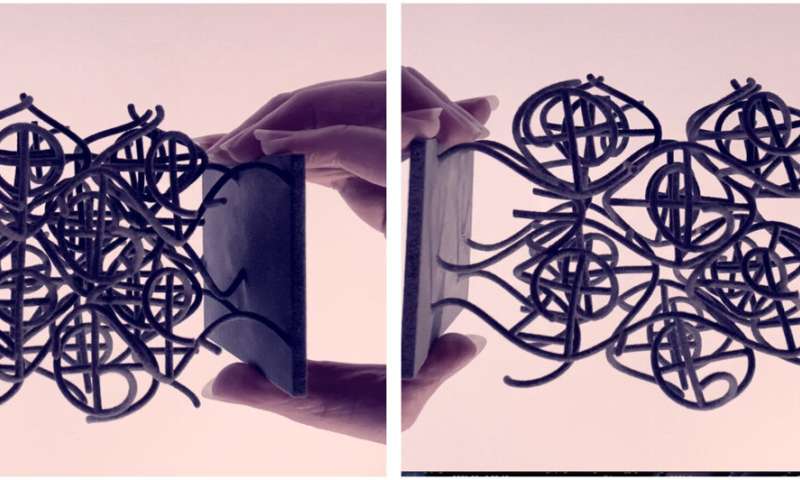
Deformation of a 3D print of a block of the tensegrity structure. The object is printed using rubber-like thermoplastic polyurethane material. The full structure is printed in the same material, so there is no differentiation made between the incompressible bars and the elastic elements. Despite this highly simplified design, we still observe auxetic behavior. Credit: Science Advances, 10.1126/sciadv.abj6737
Outlook
In this way, Mathias Oster and colleagues described a method to construct a chiral, triply periodic tensegrity structure based on high symmetry rod packing—a well known technique in structural chemistry. The work displayed local re-entrant geometry at all of its vertices to give the structure an auxetic behavior. The team showed how the auxetic behavior was also applicable to realistic material simulations. They contrasted the quantitative differences between the computation for the idealized structure and that obtained from the finite element method (FEM). They then presented a potentially simple three-periodic incarnation of the re-entrant honeycomb motif as an interesting design target for framework materials. Since the structure is chiral, too, it can be a target for metamaterials, where the chirality is a precursor to an array of functionality in materials useful for functions with electrical, optical, and magnetic properties. The described technique opens a design technology to develop a wide array of auxetic materials. While the structure instigated various explorations across the fields of algebraic geometry and optimization, it was too complex for most available numerical tools. However, from a materials science perspective, the tensegrity structure was relatively simple. The work has already prompted the development of new mathematical and symbolic approaches with optimism for the future of such studies.
More information: Mathias Oster et al, Reentrant tensegrity: A three-periodic, chiral, tensegrity structure that is auxetic, Science Advances (2021). DOI: 10.1126/sciadv.abj6737
Sten Andersson et al, Body-centred cubic cylinder packing and the garnet structure, Nature (2005). DOI: 10.1038/267605b0
Journal information: Science Advances , Nature
© 2021 Science X Network





















